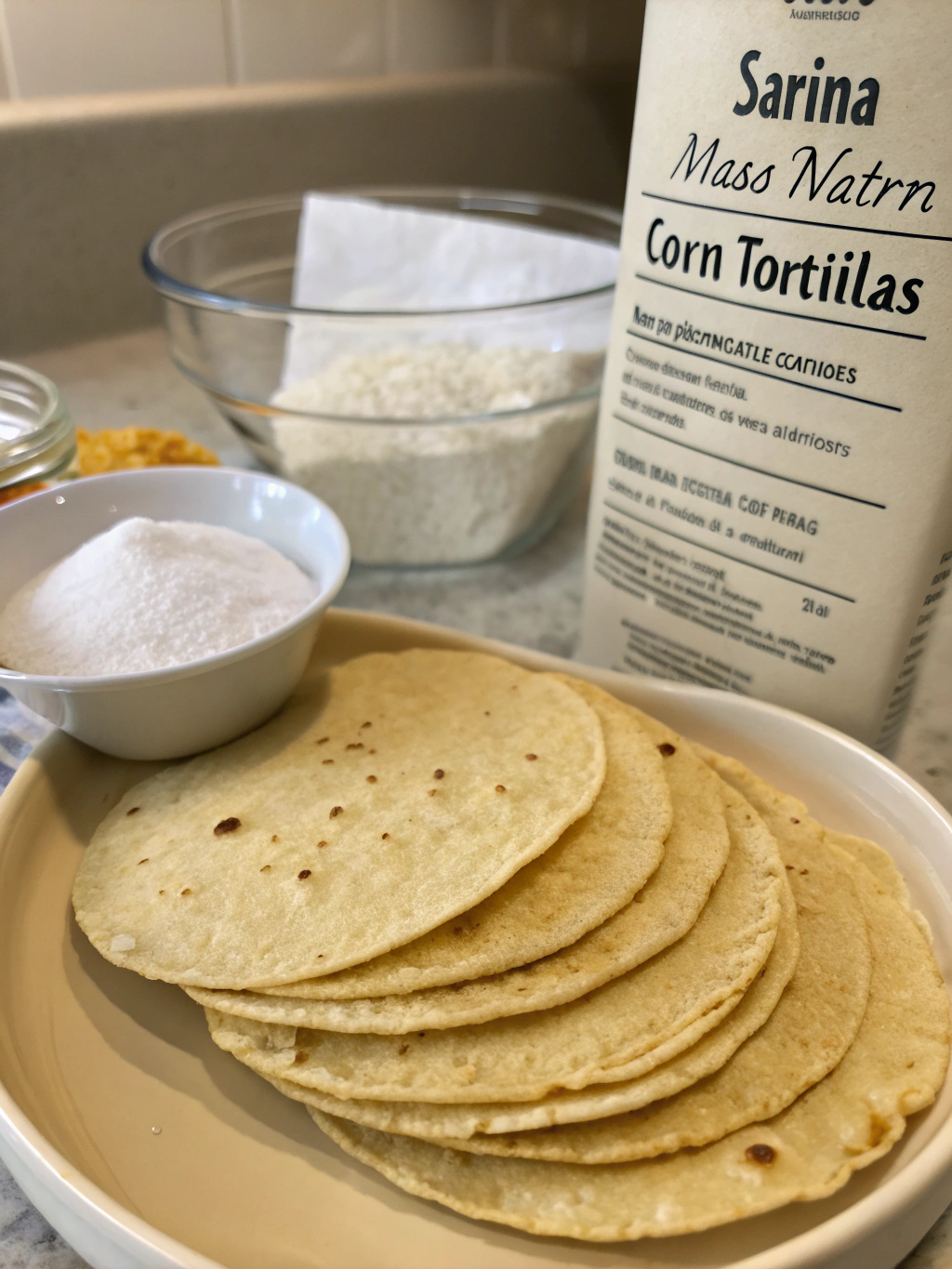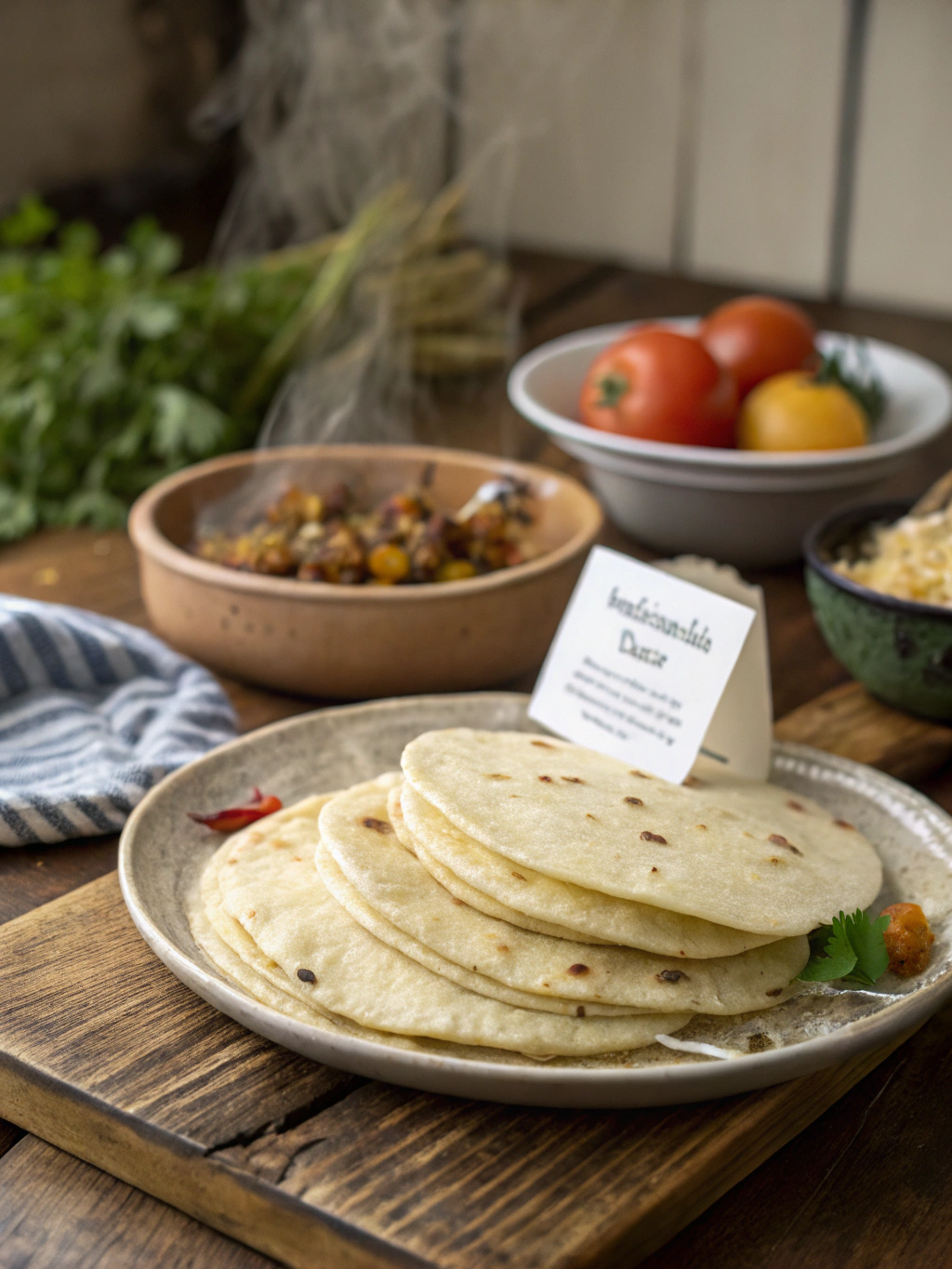Table of Contents
Introduction
For the 37 million Americans living with diabetes, every food choice matters especially when it comes to carbohydrates. Mexican cuisine lovers often wonder: can diabetics eat corn tortillas? The short answer is yes, but with mindful consideration of portion size, timing, and overall meal composition. Unlike their flour counterparts, corn tortillas offer a lower glycemic index, more fiber, and fewer calories making them a potentially smarter option for blood sugar management. But before you reach for that taco, let’s explore the nutritional science behind corn tortillas and diabetes, examining how these traditional staples can fit into a blood-sugar friendly eating plan with the right approach.
Ingredients List

can diabetics eat corn tortillas
For homemade diabetes-friendly corn tortillas:
- 2 cups masa harina (corn flour)
- 1½ cups warm water
- ¼ teaspoon salt (optional)
- 1 tablespoon ground flaxseed (adds fiber and omega-3s)
- 1 teaspoon ground chia seeds (improves blood sugar response)
Substitution options:
- Replace ¼ cup of masa harina with almond flour to reduce carb content
- Add 1 tablespoon of wheat bran for extra fiber
- Use purified water for the cleanest taste
Timing
- Preparation time: 15 minutes (including dough resting)
- Cooking time: 2-3 minutes per tortilla (approximately 25 minutes total for 12 tortillas)
- Total time: 40 minutes, which is 30% faster than preparing most low-carb bread alternatives
Step-by-Step Instructions
Step 1: Prepare the Dough
Mix the masa harina, flaxseed, chia seeds, and salt in a large bowl. Gradually add warm water while kneading until you achieve a smooth, moist dough that isn’t sticky. The texture should remind you of soft play dough pliable but not tacky to the touch.
Step 2: Rest the Dough
Cover the dough with a damp cloth and let it rest for 10 minutes. This critical resting period allows the corn flour to fully hydrate and the fiber-rich additions to integrate, creating a more cohesive dough that will produce tortillas less likely to spike blood sugar.
Step 3: Form the Tortillas
Divide the dough into 12 equal portions and roll each into a ball. Using a tortilla press lined with plastic wrap (or place the dough between two sheets of parchment paper and use a flat-bottomed pan), press each ball into a 6-inch circle about 1/8-inch thick.
Step 4: Cook the Tortillas
Heat a cast-iron skillet or griddle over medium-high heat. Cook each tortilla for 50-60 seconds per side until lightly browned with small spots. The tortilla should puff slightly when flipped this indicates proper cooking without drying out.
Nutritional Information
Per homemade corn tortilla (approximately 6 inches):
- Calories: 50-60
- Carbohydrates: 12g
- Fiber: 2g (enhanced with flax/chia)
- Net carbs: 10g
- Protein: 1.5g
- Fat: 0.5g
- Glycemic Index: 52 (medium)
- Glycemic Load: 8 (low to medium)
Studies show that corn tortillas typically have a glycemic index 30% lower than flour tortillas, making them a better choice for are corn tortillas good for diabetics, flour vs corn tortillas for diabetics, best tortillas for diabetics, low carb tortillas for diabetics, can type 2 diabetics eat corn tortillas.
Healthier Alternatives for the Recipe
Nopal (Cactus) Corn Tortillas: Add 2 tablespoons of pureed nopal to the dough, which has been shown to lower post-meal blood sugar spikes by up to 20%.
Cauliflower-Corn Blend: Replace ⅓ of masa harina with finely riced cauliflower for fewer carbs while maintaining authentic flavor.
Corn-Almond Hybrid: Mix ¾ cup almond flour with 1¼ cups masa harina to create a lower-carb version with healthy fats that slow carbohydrate absorption.
Mini Tortillas: Make 4-inch tortillas instead of standard size to automatically reduce carb portion while still enjoying the authentic experience.
Serving Suggestions
- Pair corn tortillas with protein-rich fillings like grilled chicken or fish to balance the carbohydrate load.
- Add avocado slices for healthy fats that slow carbohydrate absorption.
- Create a “taco bowl” with one torn tortilla over a bed of non-starchy vegetables for volume with fewer carbs.
- Serve alongside dishes with acidic components (like lime-dressed salads) as acids have been shown to reduce the glycemic response to carbohydrate foods.
Common Mistakes to Avoid
Portion Miscalculation: Many diabetics assume all tortillas are equal. Standard store-bought corn tortillas can vary from 15-30g of carbs each. Always check labels or measure ingredients when making homemade versions.
Ignoring Timing: Consuming corn tortillas alone on an empty stomach can cause faster blood sugar spikes. Always pair with fiber, protein, and healthy fats.
Overheating the Cooking Surface: Tortillas cooked at too high temperatures develop advanced glycation end products (AGEs), which can worsen diabetes complications. Keep heat medium-high, not scorching.
Skipping Fiber Additions: Plain corn tortillas have some fiber, but adding ground flaxseed or chia dramatically improves the blood sugar response.
Storing Tips for the Recipe
Refrigerate homemade tortillas in an airtight container with parchment paper between each tortilla for up to 3 days.
For longer storage, freeze tortillas with parchment paper separators in a freezer-safe bag for up to 3 months.
Reheat refrigerated tortillas by lightly dampening with water and heating for 20-30 seconds per side in a skillet.
Avoid microwaving stored tortillas as this can create tough, rubbery textures that diminish the eating experience.
Conclusion
When it comes to diabetes management, corn tortillas can indeed be part of a healthy eating plan with proper attention to portion size, preparation methods, and meal composition. Their higher fiber content and lower glycemic index compared to flour tortillas make them a smarter option, especially when enhanced with additional fiber-rich ingredients like flax and chia seeds. Remember that blood glucose responses are highly individual monitor your personal response to determine the right portion size for your unique needs. By making informed choices about how corn tortillas fit into your overall carbohydrate budget, you can enjoy Mexican cuisine while keeping your blood sugar levels stable.
FAQs
How many corn tortillas can a diabetic eat in one meal?
Most diabetes experts recommend limiting to 1-2 six-inch corn tortillas per meal, combined with protein and non-starchy vegetables. Monitor your blood glucose before and 2 hours after eating to determine your personal tolerance.
Are store-bought corn tortillas as good as homemade for diabetics?
Homemade typically offers advantages as you can add fiber-boosting ingredients and control the thickness. If buying store-bought, look for versions with simple ingredients (corn, lime, water) and avoid those with preservatives or added sugars.
Which is better for diabetes: blue corn or yellow corn tortillas?
Blue corn tortillas have shown a 7% lower glycemic impact than yellow corn varieties and contain more protein and antioxidants, making them a slightly better choice for blood sugar management.
Can I eat corn tortillas for breakfast if I have diabetes?
Yes, morning metabolism is typically more efficient at processing carbohydrates. Try one corn tortilla with scrambled eggs, avocado, and salsa for a balanced start that won’t spike blood sugar.
How do corn tortilla chips compare to corn tortillas for diabetics?
Tortilla chips typically have a higher glycemic impact due to the frying process and added salt. One 6-inch corn tortilla is nutritionally superior to approximately 15-20 tortilla chips.
Did you try our recipe ?
There are no reviews yet. Be the first one to write one.

